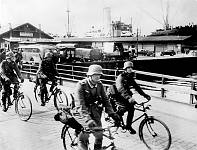This week in the war, in the early hours of Tuesday 9 April 1940, Danish civilians were awoken by the sound of German bombers flying low over the rooftops. The Phoney War was over and the Hitler’s invasions of Denmark and Norway had begun.
With Copenhagen in enemy hands, the Danes surrendered the following day. The Norwegians fought on.
In Norway, the Germans had staged seaborne landings at Oslo, Kristiansand, Bergen, Trondheim, and also at Narvik in the north. They had sent airborne troops to seize Stavanger. Germans  soldiers are shown (left) on bicycles, pedalling away from the docks in Oslo.
soldiers are shown (left) on bicycles, pedalling away from the docks in Oslo.
Norway was of strategic importance, both as a base for U-boats and German surface raiders, and as an ice-free supply route for shipments of Swedish iron-ore via the port of Narvik.
The German navy suffered heavily, losing the the heavy cruiser Blucher and light cruisers, Karlsruhe and Konigsberg. Royal Navy Captain Warburton-Lee was awarded a posthumous Victoria Cross after leading his his destroyer flotilla into Narvik Fjord (also called Ofotfjord), where he surprised ten German destroyers, sinking two of them, along with several transports. Two of his own ships were lost in the battle.
 In the Second Battle of Narvik, 13 April 1940, the veteran World-War-I British battleship, HMS Warspite, entered Narvik Fjord with a squadron of nine destroyers (including HMS Cossack of ‘Altmark‘ fame). In the subsequent action, seven German destroyers were sunk or were beached and abandoned by their crews.
In the Second Battle of Narvik, 13 April 1940, the veteran World-War-I British battleship, HMS Warspite, entered Narvik Fjord with a squadron of nine destroyers (including HMS Cossack of ‘Altmark‘ fame). In the subsequent action, seven German destroyers were sunk or were beached and abandoned by their crews.
The Norwegians, supported by British, French, and Polish troops, fought on but, by early May, most of southern Norway was in German hands. By early June, the last remaining units of the Allied expeditionary force were evacuated from Narvik. King Haakon and his cabinet ministers left Tromso on 7 June and sailed to Britain, where they formed the Norwegian government-in-exile.
The German pre-World-War-I battleship Schlesien (which the treaty of Versailles allowed Germany to retain) is shown left, steaming through a Norwegian fjord.


